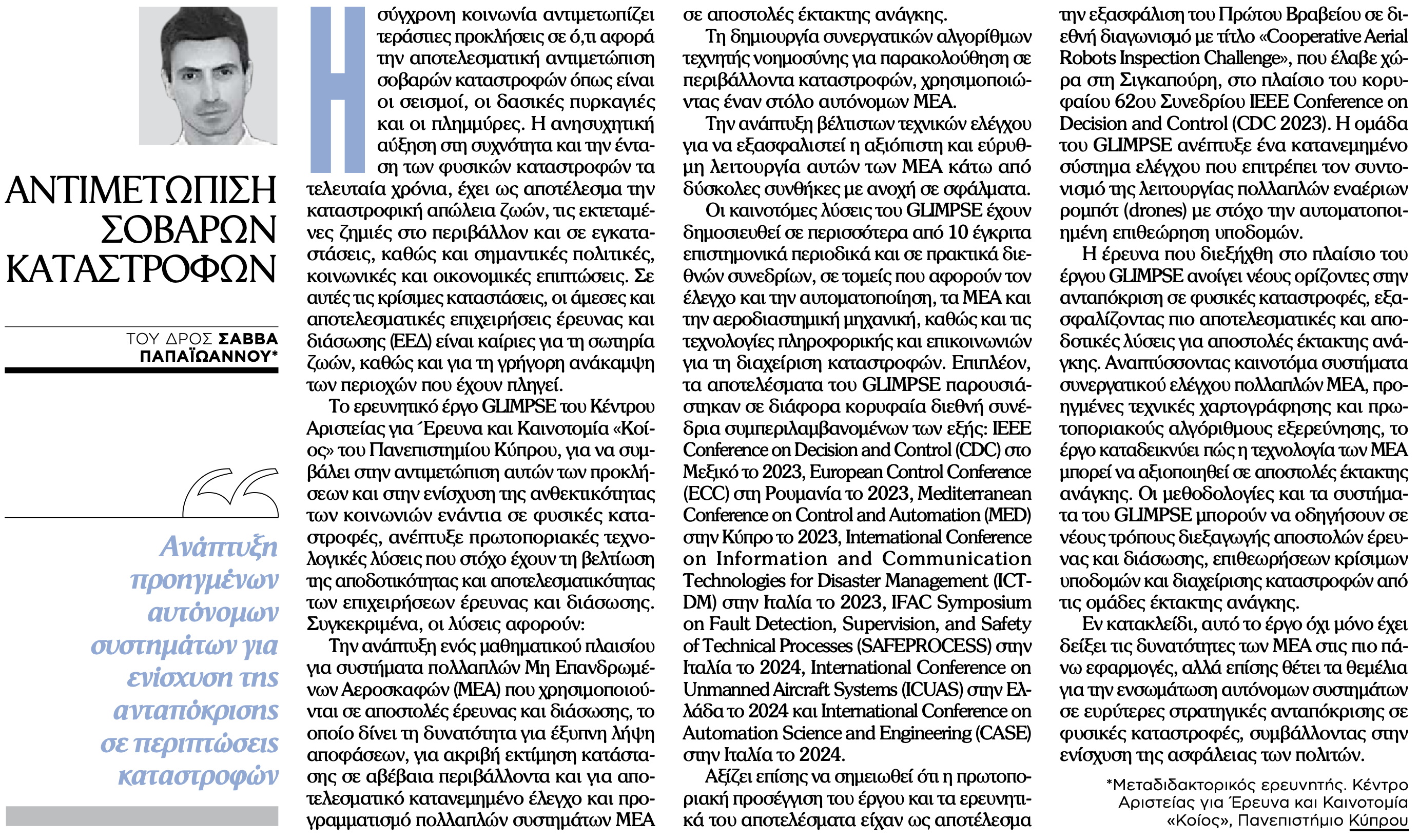media
Revolutionizing Disaster Response with Flying Robots
- Date: August 2024
- Description: My research on innovative autonomous flying robots (i.e., drones) for enhancing disaster response (project GLIMPSE) is featured in several of Cyprus’s leading newspapers, including the two oldest and largest Greek-language daily print newspapers, Phileleftheros and Alithia, as well as on popular news and media platforms Omega Live and Paideia News. The article discusses groundbreaking research in autonomous multi-agent systems, distributed control, and artificial intelligence for automated disaster response using a fleet of flying robots. The research addresses numerous challenges in disaster response, including intelligent decision-making, accurate state estimation in uncertain environments, and efficient multi-drone cooperative control and planning for enhancing search and rescue operations and emergency response missions. The article, in its original Greek version, can be accessed in Phileleftheros here and in Alithia here. The article is also available online from Omega Live here and from Paideia News here. A translated English version can be found here.

Automated Infrastructure Inspection with Drones
- Date: Thursday, 21 December 2023
- Description: My research on infrastructure inspection using multiple cooperative robots was highlighted in a press release by the University of Cyprus. Leading my team at KIOS CoE, we secured the First Prize in the “Cooperative Aerial Robots Inspection Challenge” at the prestigious 62nd IEEE Conference on Decision and Control (CDC 2023), held from December 13-15, 2023, in Singapore. The article can be accessed in Greek here, and in English here.
Understanding Energy Consumption and Identifying Anomalies
- Date: April 2012
- Issue: Vol. 85 No. 3
- Description: My research on understanding the energy consumption behavior of large buildings, identifying energy consumption patterns, and detecting novel events as part of the Intelligent Buildings project is featured in the Yale Scientific magazine. Under the guidance of my supervisor, Prof. Andreas Savvides, I pioneered the creation of novel machine-learning techniques that learn a building’s consumption behavior, adapt to changes in consumption patterns, and pinpoint anomalies. I developed a learning architecture that closely resembles today’s modern Autoencoder Artificial Neural Networks (although this was conceived before the deep-learning and AI boom). I gathered hourly power consumption data from Rosenkranz Hall, a 60,000 sq. ft. building at Yale that we had instrumented, and organized this data into daily segments (each comprised of 24-dimensional vectors), dividing it into training and test sets. By integrating Correspondence Analysis (CA), a dimensionality reduction technique, with Self-Organizing Maps (SOM) - a type of artificial neural network known for creating spatially organized internal representations of input features - I enabled unsupervised learning of a latent representation of normal power consumption patterns, which, in turn, facilitated the detection of novel events. In this setup, CA functioned similarly to the encoder part of an Autoencoder, enabling efficient low-dimensional representation of the input, while the SOM served a role analogous to the decoder, which is typically utilized in anomaly detection. The issue can be accessed here.